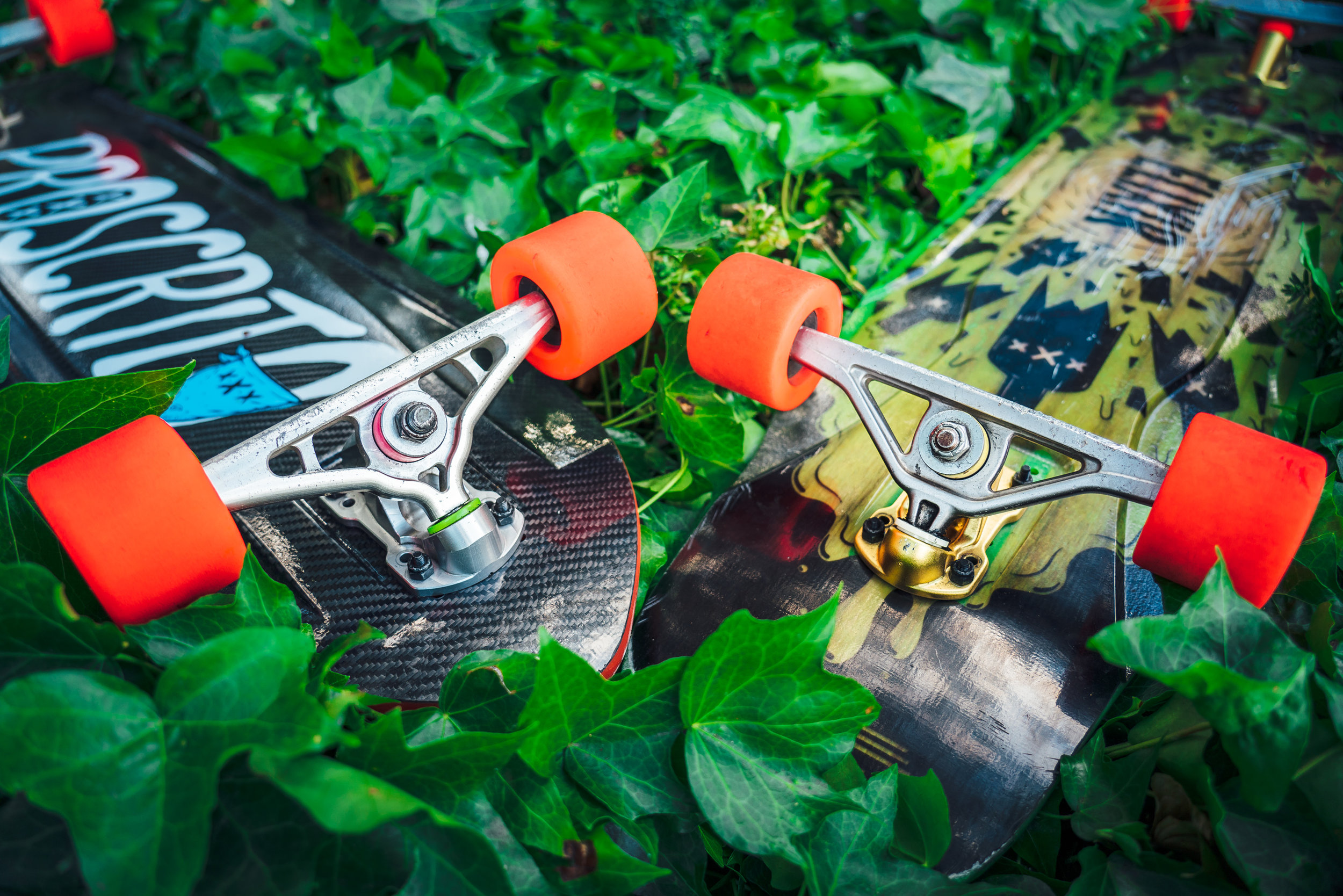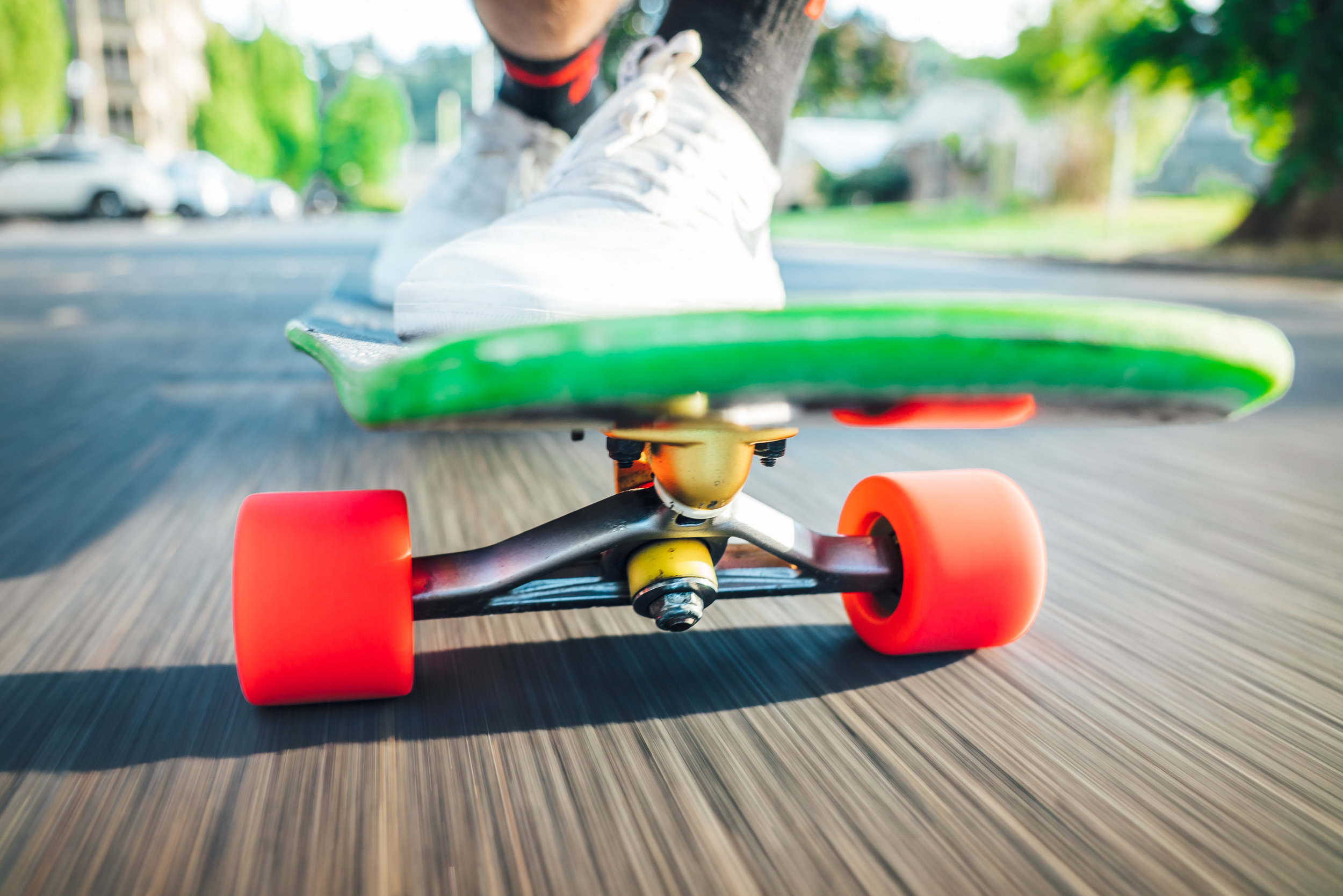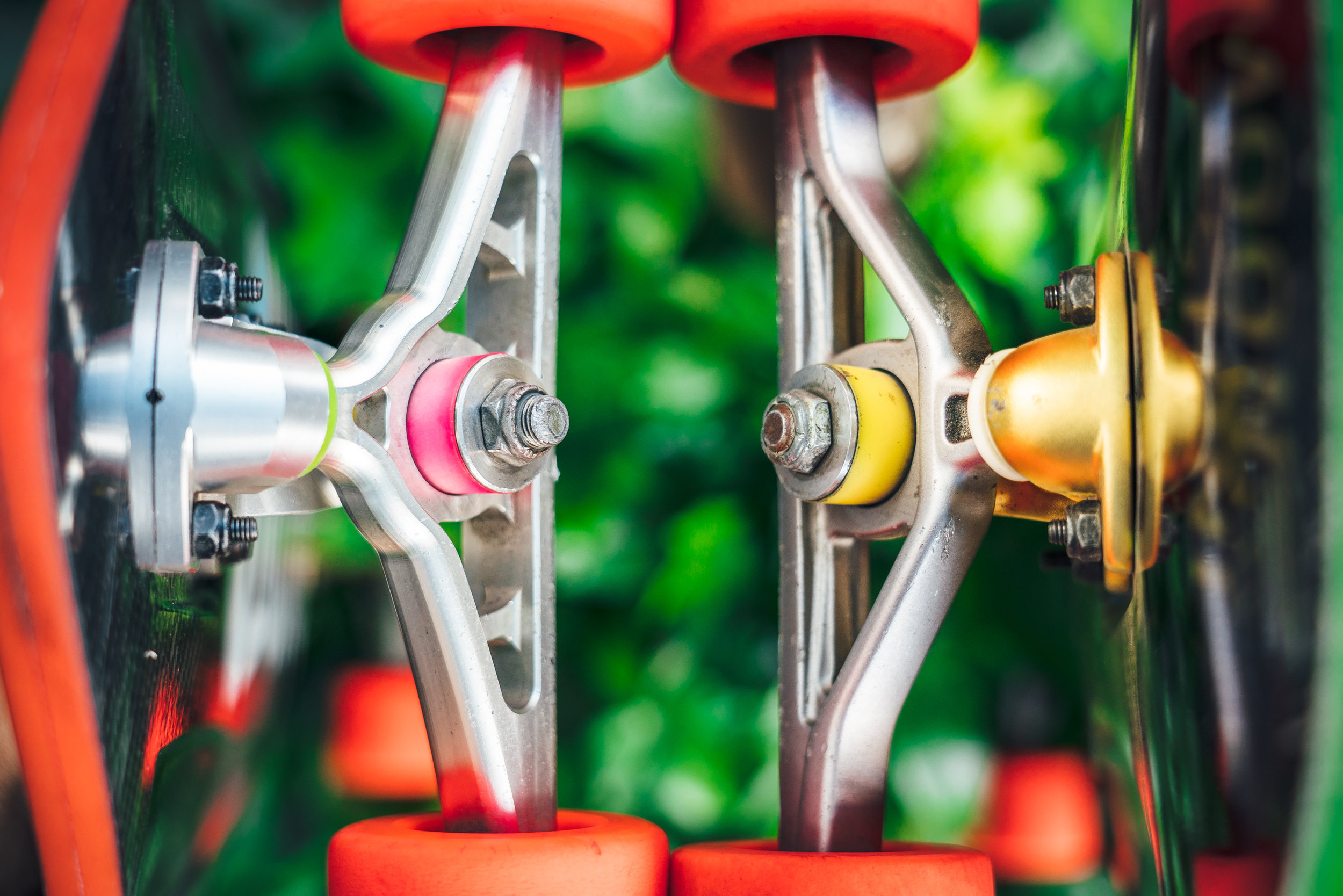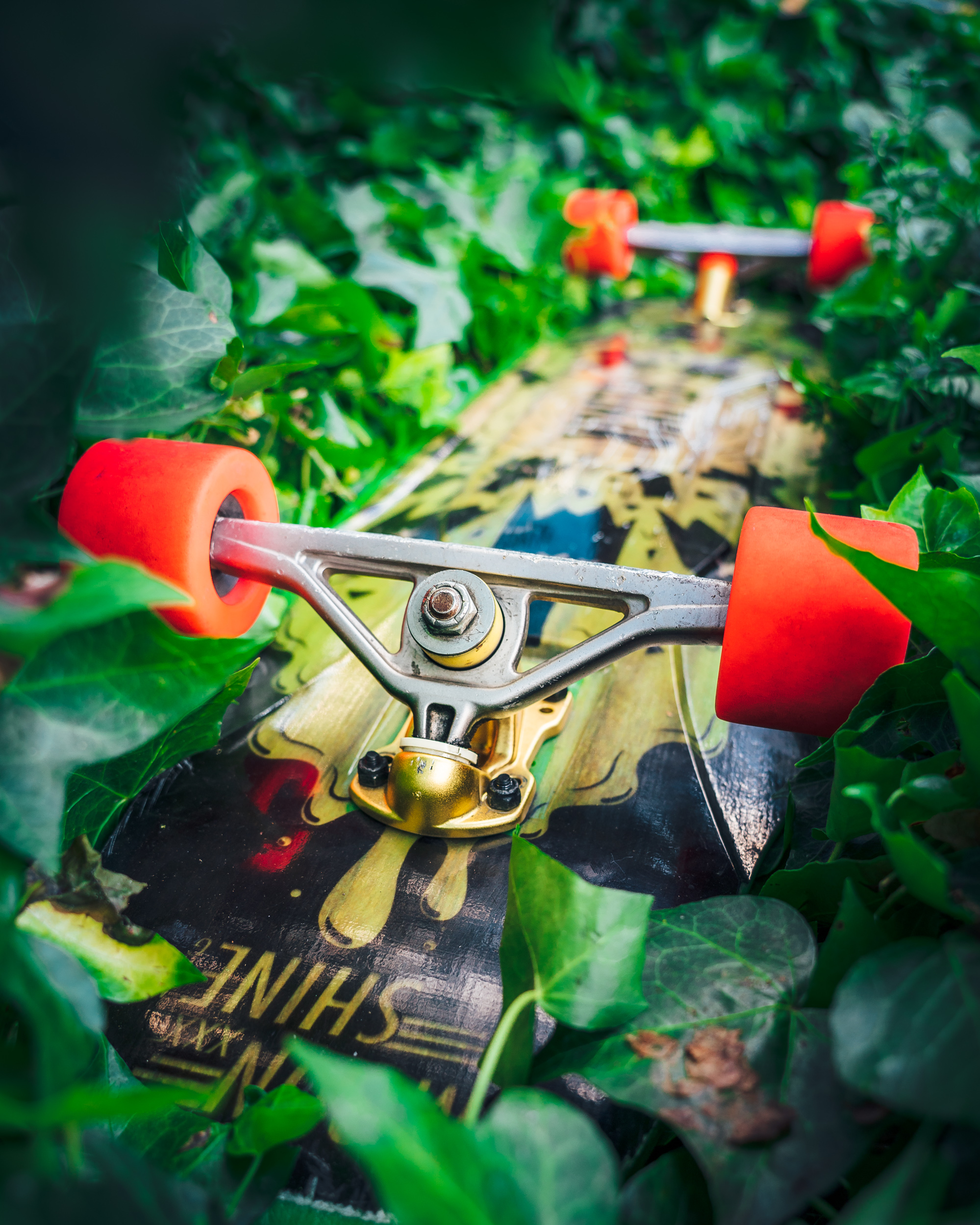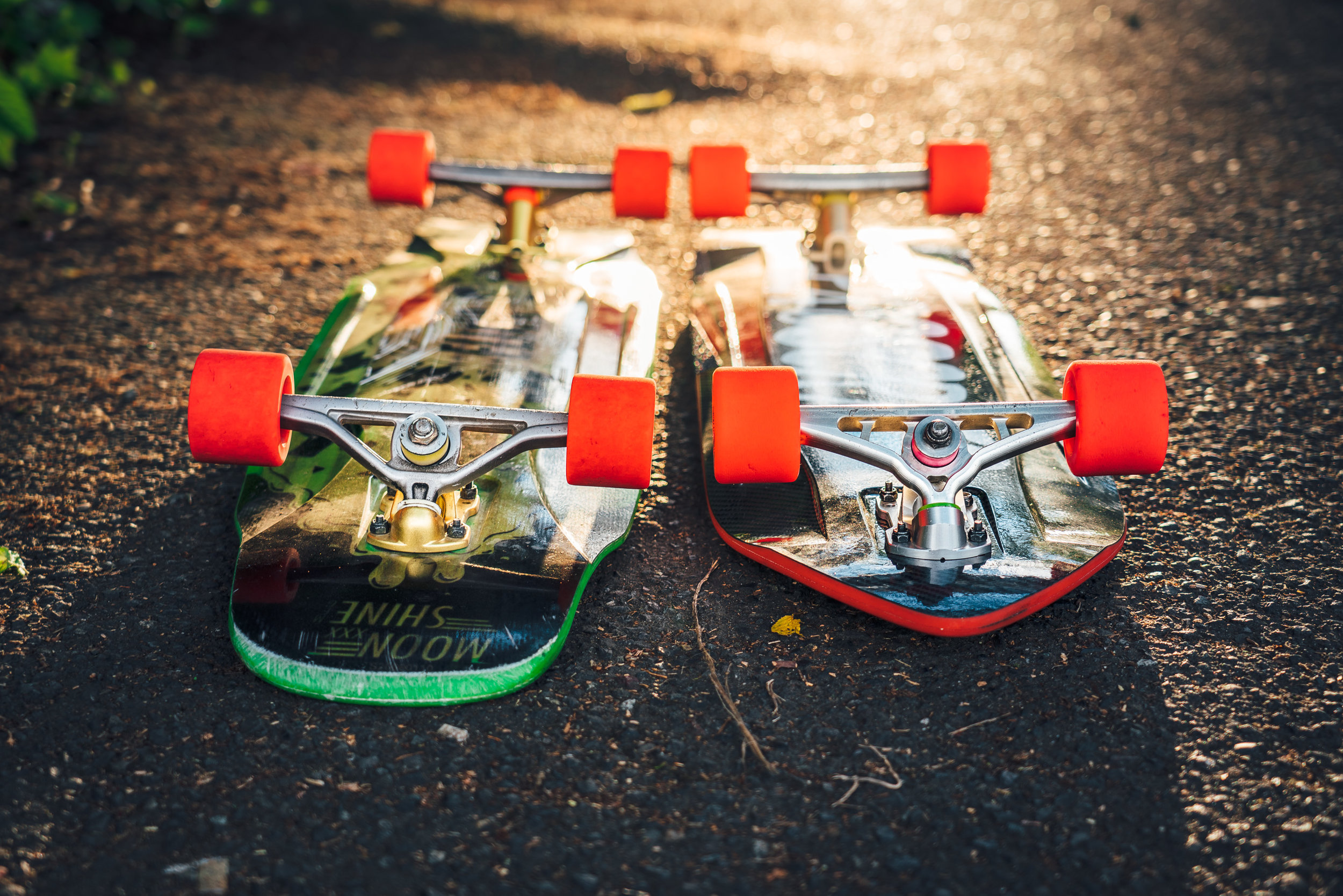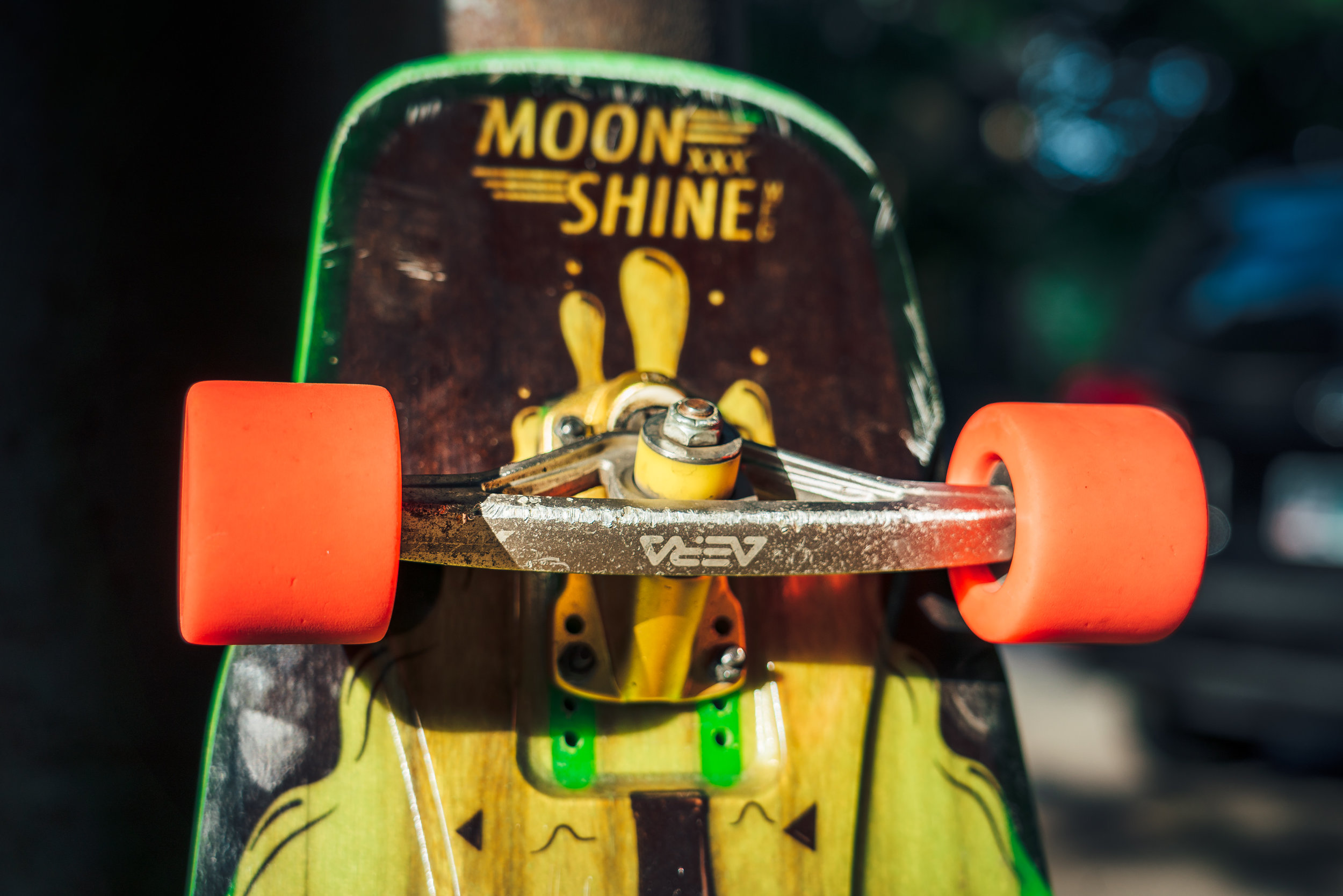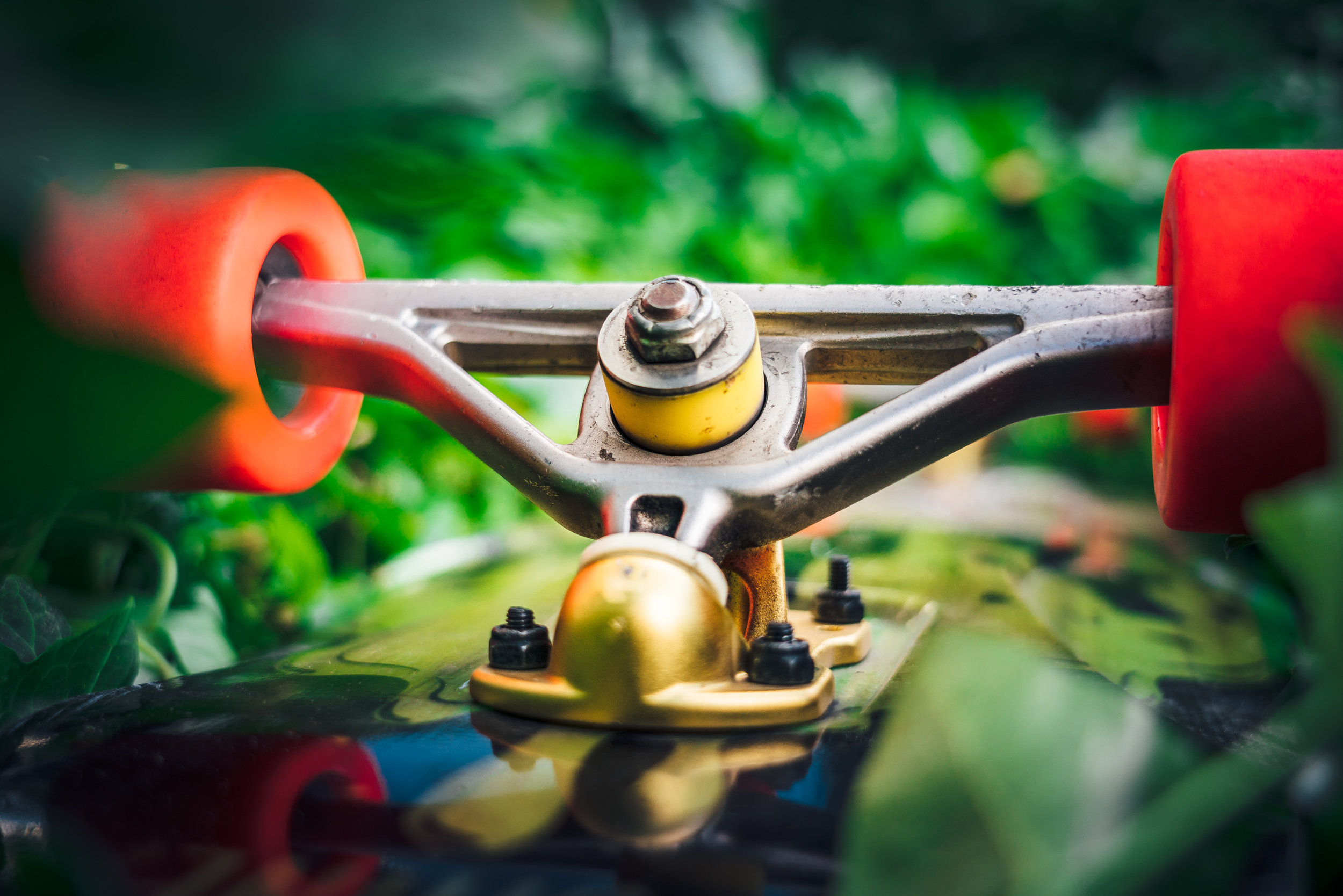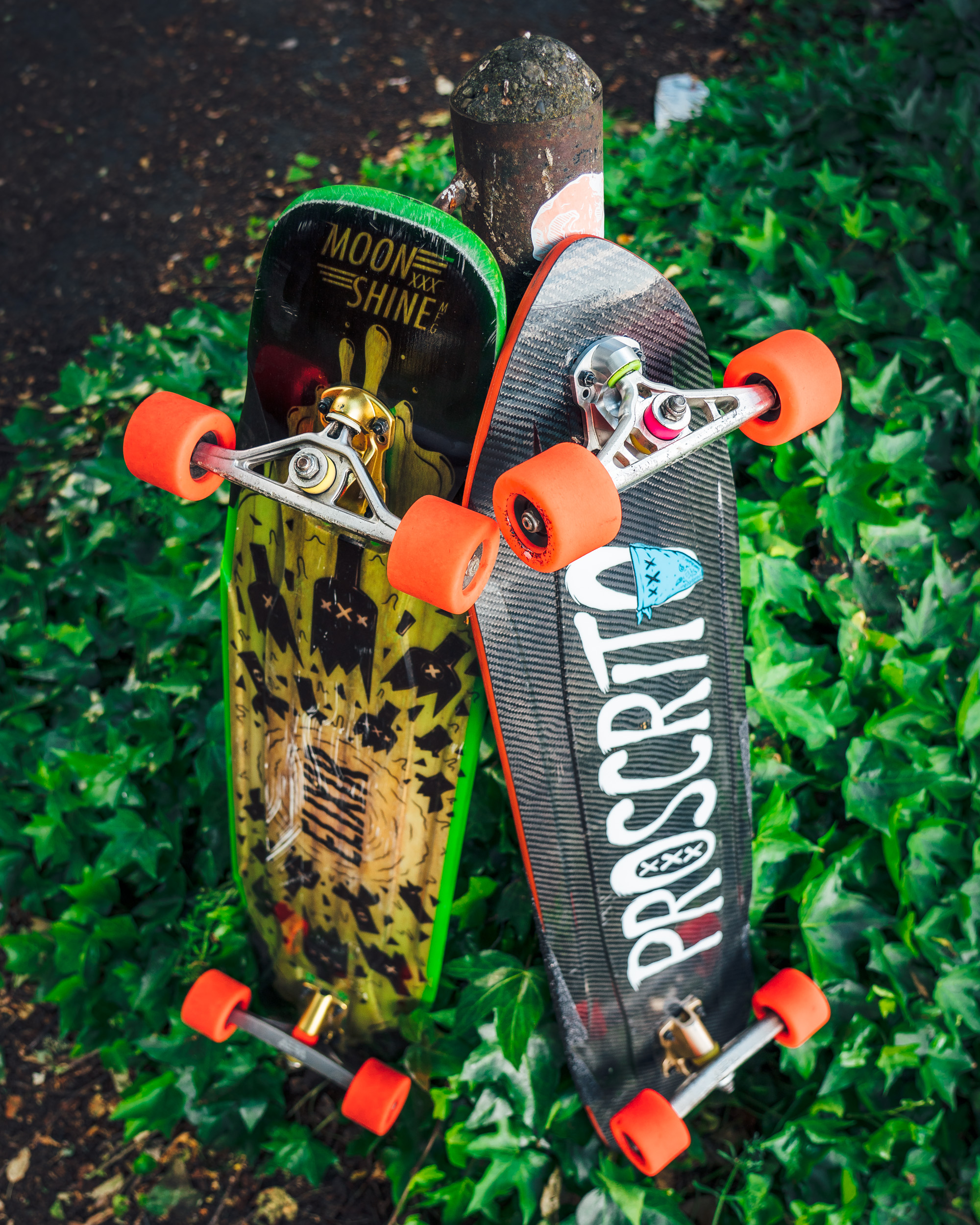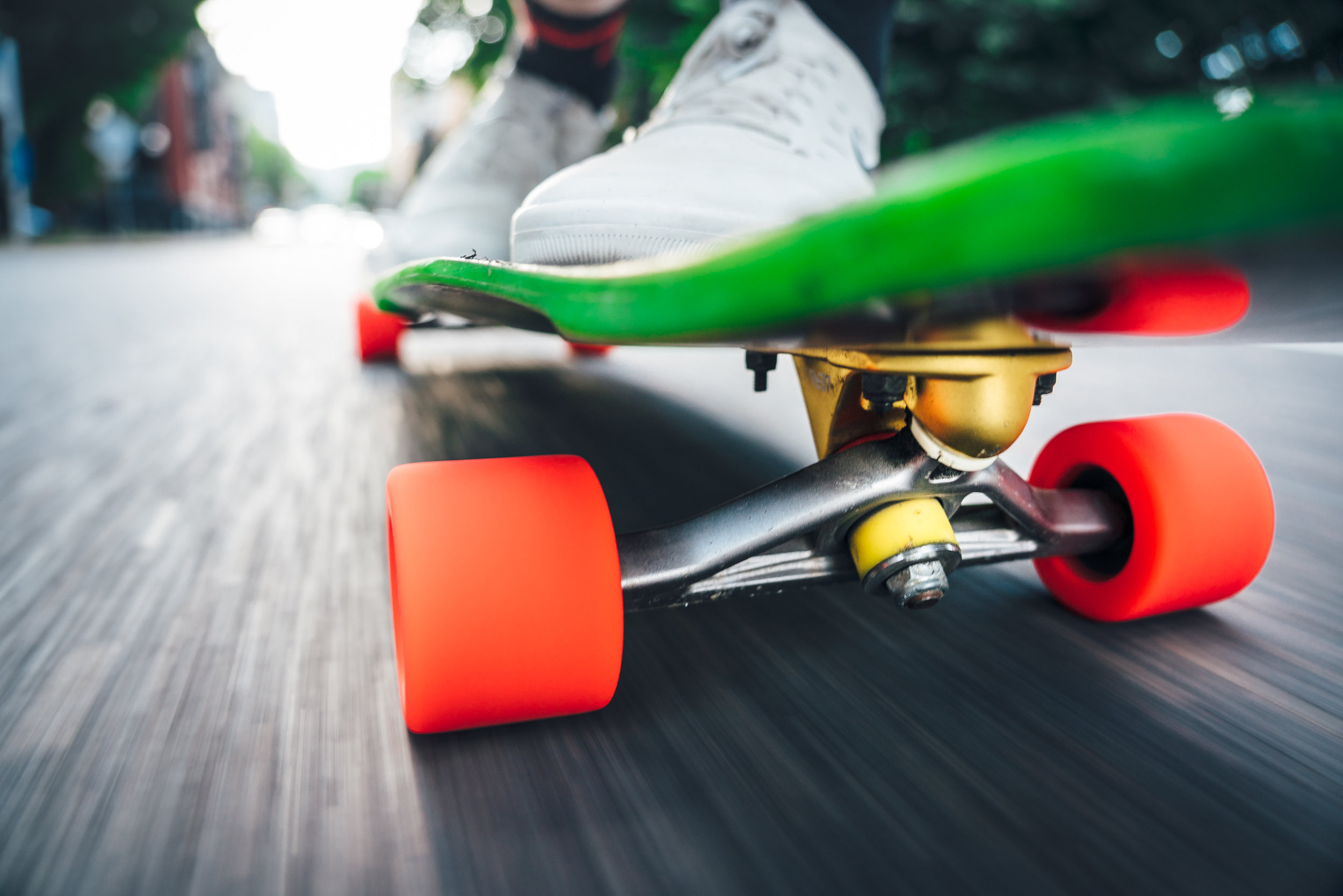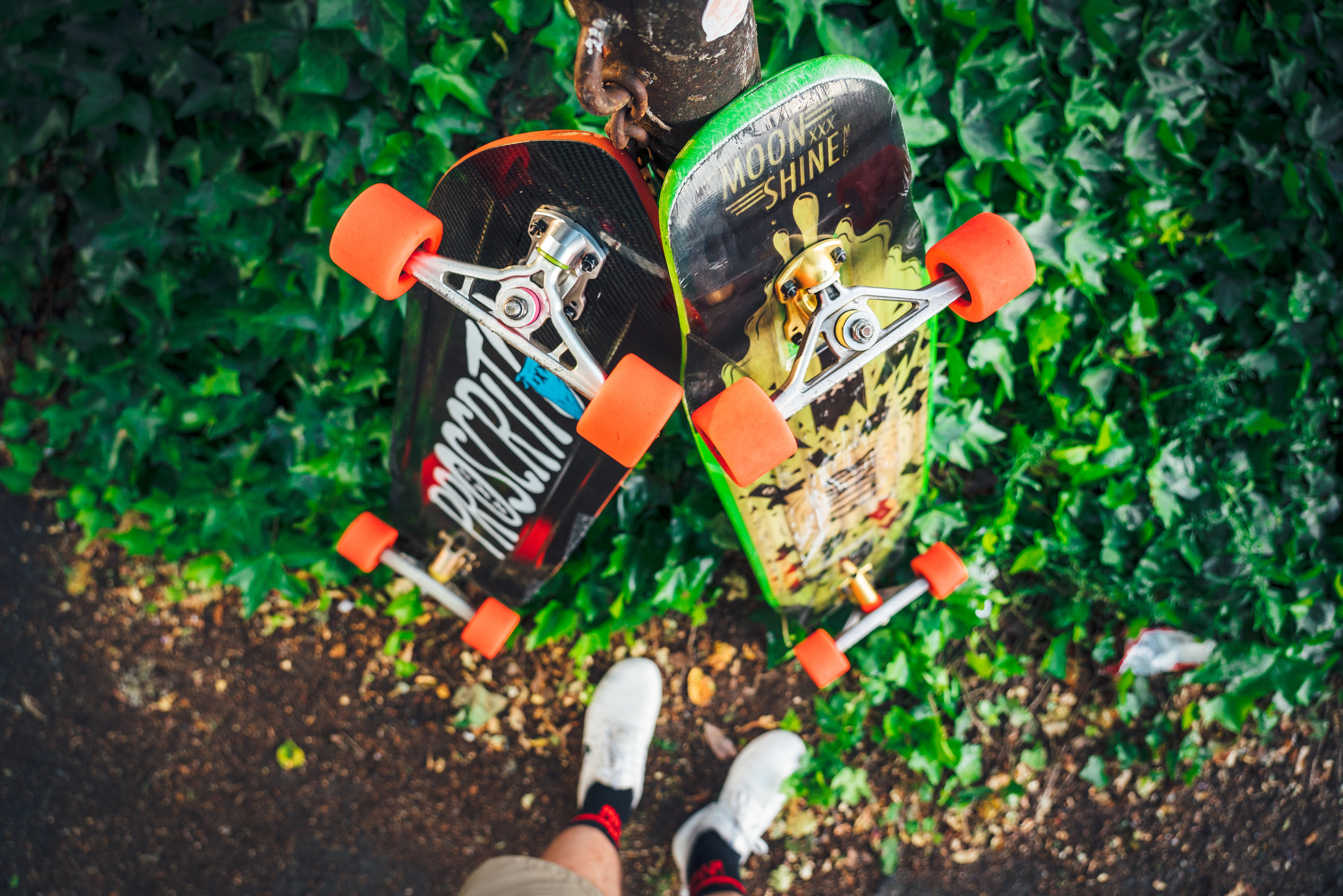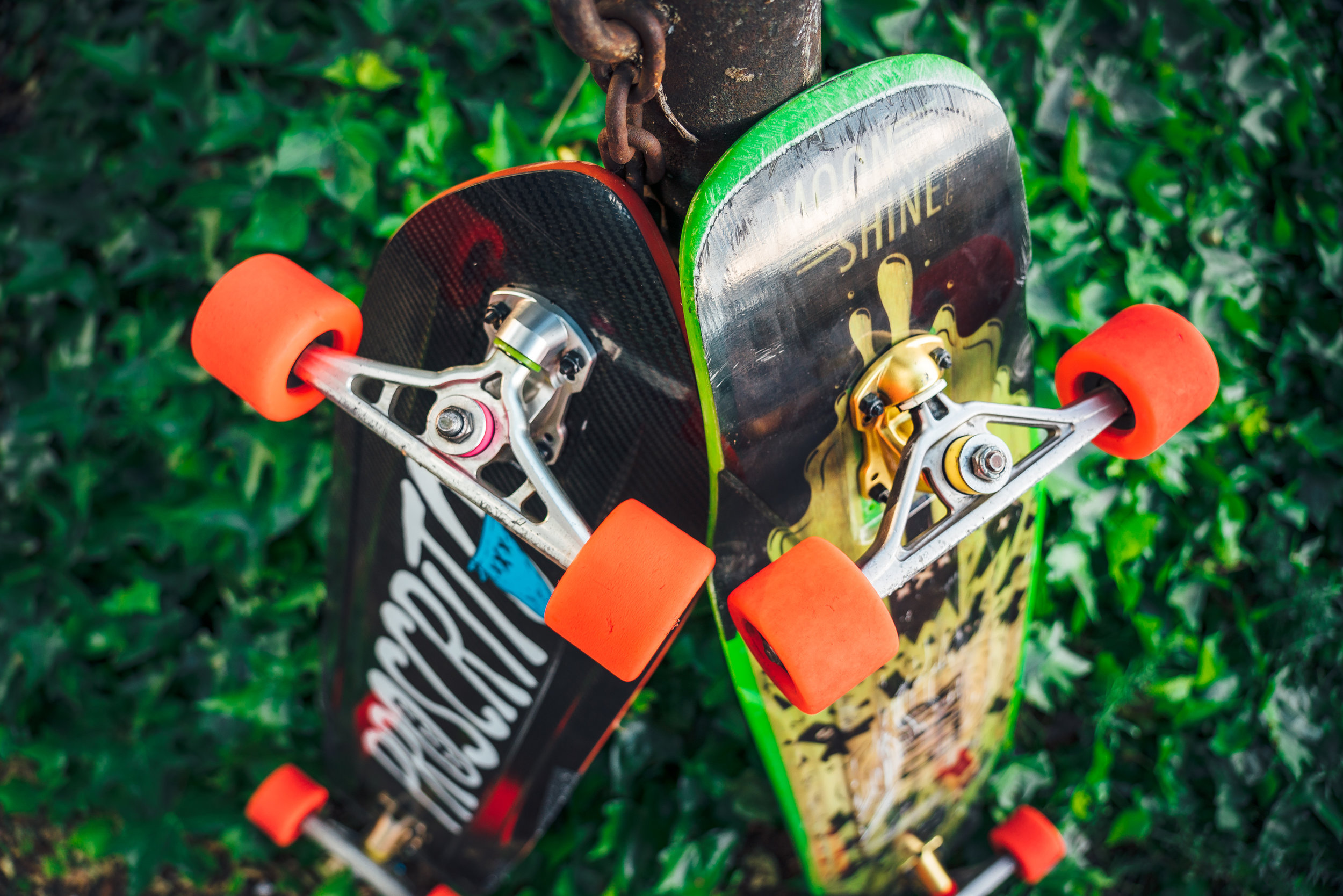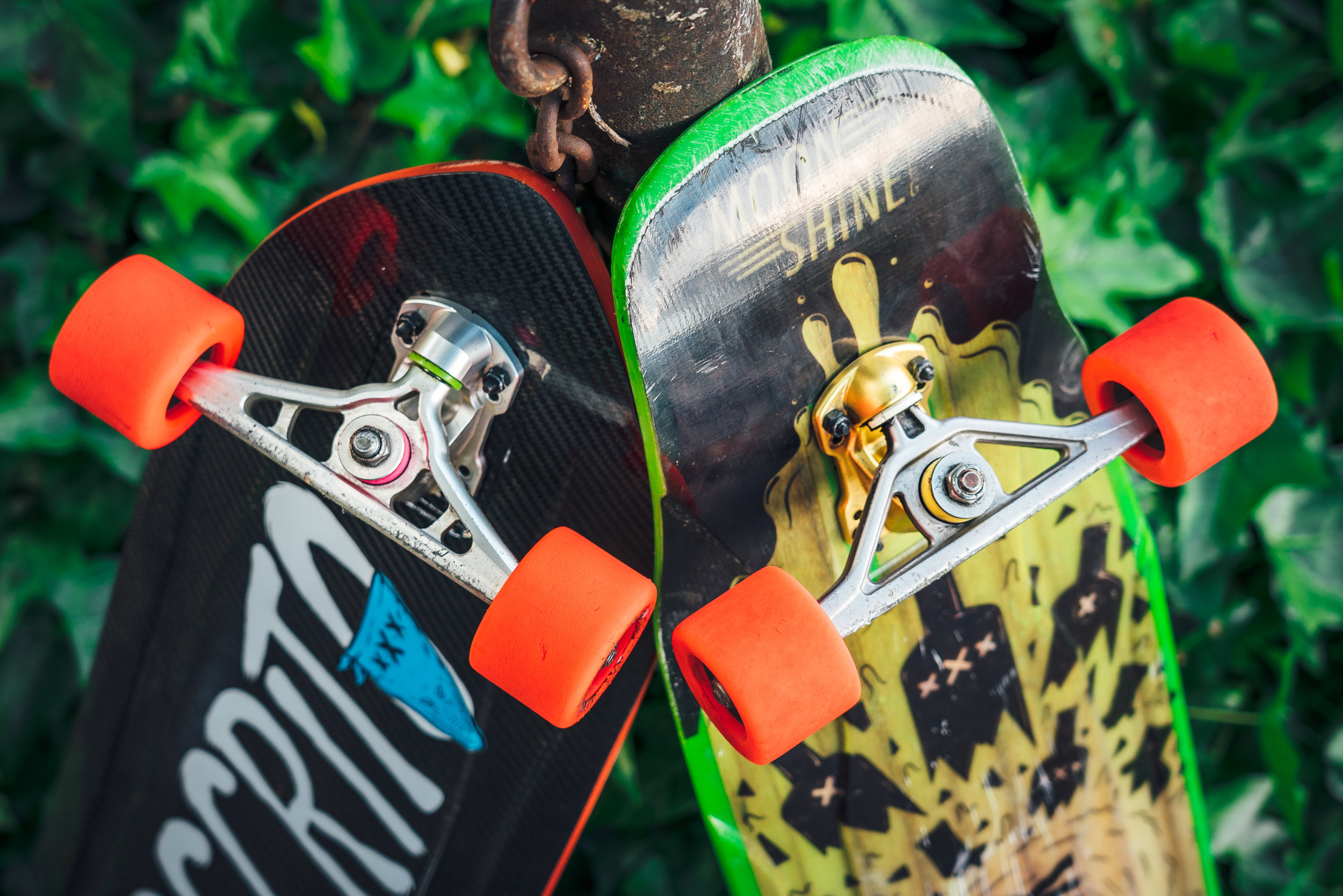Aera K5 vs. Aera RF-1 Which is right for you?
Choosing the right longboard trucks is arguably the most important decision of your set-up. Trucks determine your flow and overall riding style. Since the recent release of the Aera RF-1s, I’ve received countless questions as to what they’re all about and why someone might want these over the more downhill-focused K5s or vice-versa. In this post I’m going to talk about the history of Aera Trucks, the differences between the new RF-1s and K5s, and which one will fit your style best.
Left: 168mm 46°/42° Aera K5 precision trucks. Right: 180mm 46° RF-1 forged longboard trucks.
Aera K5s are built for downhill and stability
These trucks are “simply better”
The Aera K3 and K4 precision trucks set the stage for the development of the K5, which is the continuation of their design ethos - "simply better". Adding complexity, extra parts, or changing up how skateboard trucks work isn't necessary when you optimize geometry, structural design, bushings, pivot cups and materials. Skateboard trucks have been relatively the same for decades, and for good reason. They simply work well for what we do.
Skating should be simple. Grab your board, and GO. You should be able to enjoy your trucks in all varieties of skating, and Kevin has optimized the K5s to do so. With the addition of a significantly larger pivot nose and refined geometry, these trucks were designed to blend comfort, liveliness, and stability at a wide range of speeds. From 20km/h - 120km/h, Aeras just feel great!
My experience with the Aera K5
I got my first set of K5s February 2017 from Kevin Reimer at Guajataca Downhill in Puerto Rico when I joined the Aera team. They were 168mm and 46°. Before then, I was riding the Liquid Trucks “Fyre” in 160mm 45°/30°. The Fyre truck was interesting because it had a support system to help give a more direct and responsive turn. They raced well and felt solid on courses with smooth pavement, but felt super rough and robotic for ANYTHING else. Moving to the Aera K5s was like day and night. My set-up instantly came to life! Since my first set I’ve experimented with all sorts of bushing set-ups and splits.
For the majority of 2017 I rode the 46°/42° K5s on my Moonshine Outlaw. This set-up was quite surfy and felt super fun for basically any hill I took it down. As soon as I left for racing eurotour I changed to a 30° baseplate in back and threw these trucks on my Moonshine Pro Tucker to add more stability to my ride. This definitely made for a more racey set-up but overall felt less enjoyable for general freeriding. At Transylvania Downhill Vulcan in Romania I decided to test out 42°/30° plates due to the courses insanely fast top speed of 70+mph. I’m glad I did! This is one of those roads where every bit of stability is a needed to survive. Below is a video from a “chill” stand-up run I took at this event on some super slippery wheels:
Nowadays I have my 168mm Aera K5s mounted on my Moonshine Proscrito at 46°/42° and love it! After 2.5 years of experimenting, I find this combination to be the ultimate balance between stability and liveliness for downhill descents.
Aera RF-1s are made for the riding we do most
Precision quality at half the price
With the emergence of forged longboard trucks, you can now have precision-like quality and strength at half the price.
The RF-1 truck was designed with several ideas in mind, but the most important was making an Aera Truck that was more accessible in price. They were specifically optimized for the type of skating that we do most - freeride, and skating around town. The RF-1 is truly one of the most fluid trucks I've ever skated at slower speeds. By utilizing a new pivot cup design that fully encapsulates the ball pivot and adds surface area, you can steer deeper since it doesn't bind. This is critical for locking in slides and deep snappy carves.
My experience with the Aera RF-1
I tested my first set of Aera RF-1 prototypes in May 2017. From the first time stepping on them I was surprised by how lively they were - especially with the hardcore bushings that came stock. Soon after I threw in some RipTide 90a APS Canons (slightly larger barrel) roadside, and some 90a Krank Fatcones boardside. This change gave a lot more stability to my ride, and I felt much more comfortable tackling the steep Californian slopes.
I then tried flipping the hangers for negative rake and got ever more stability out of my speed and fast slides. Still not as much stability as my K5s, but definitely an improvement over how they felt stock. The only downside to negative rake was that the ball pivot allowed for extra flex and slop in the truck so the turn became super dead at slower speeds. I soon switched back to positive rake and felt these trucks come alive once again. Although, the benefits of the ball pivot design seemed to be more of a downside when going really fast. The more I experimented with the RF-1s, the more I realized how amazing they were for slower speeds.
In late 2017 I was just getting into longboard dancing, and decided to throw some 180mm 50° RF-1s on my Moonshine Hoedown. These trucks were definitely a game changer! They’re lighter than almost any other truck on the market and have such a very responsive carve. On top of that, they’re much much stronger than any cast I had on my board before. Technical freeriding, city slashing, longboard dancing and freestyle is where these trucks really shined for me.
Currently, I have one set of 176mm 46° RF-1s mounted on my Moonshine Elixir and one set of 180mm 50° RF-1s mounted on a 46” Moonshine prototype dancer.
So, which trucks are right for you?
Each of these two models have unique strengths and weaknesses. I’ll summarize this below:
The Aera K5 precision trucks have the following advantages:
Stable at high speeds, but still lively for general freeride.
They’re built super strong and will last for many years with proper maintenance.
Available with 50°, 46°, 42°, and 30° baseplates which allow for advanced tuning.
The Aera RF-1 forged trucks have the following advantages:
Much more affordable price ($190 in the USA).
Extremely lightweight at only 398g per truck including bushings, axels, etc.
Use the same precision axels and kingpins as the K5s.
Exceptional carve tuned for dancing, freestyle, and freeride.
I choose to ride the K5s when I need more stability and will be generally riding above speeds of 30mph. These are the trucks on my race board, but you’ll never see them on my cruisers.
I choose to ride the RF-1s for basically anything else. These trucks really excel where you want a quick and snappy response.
In case you’re interested, I included additional information below about the history of Aera trucks and why they decided to use larger 1” bushing seats in the K5 and RF-1.
Additional Information
History of Aera Trucks
Aera Trucks has been synonymous with high performance downhill skateboarding since Kevin Reimer started the company back in 2009. After riding every truck that was available at the time he soon realized that they all had some fundamental flaw that limited his riding ability. He always needed two fully loaded set-ups. One for longboard racing and one for freeriding.
He figured that if he could spend all of his time on just one set of trucks he would both freeride and race better. By starting his own precision truck company, he would finally have control to make any and all changes to his set-up that would help enhance his unique riding style. Thus, Aera Trucks was born.
In late 2013 Kevin sold Aera Trucks to SkateOne Corp (Powell-Peralta, Bones, Mini-Logo, etc). There were several reasons that influenced this move, but above all he saw the potential in merging with one of the largest and most trusted skateboard equipment manufacturers of all time. Being a part of something bigger gave Aera more access to the market, and a huge suite of development tools like in house engineers and an actual RnD department.
Up close and personal with the Aera RF-1 forged longboard truck. These are 180mm and 46°.
Why did Aera make larger bushing seats?
In both the K5 and RF1, Aera opted for a slightly larger 1" bushing size compared to the .96” industry standard. Aera did this for several reasons, but generally they feel that this is the where the market is going. Urethane tends to shrink between 4-5% when it cools down, and most manufacturers choose to make bushings using a 1" bore in their moulds. This makes .96" bushings when the urethane shrinks.
Being that Aera makes their molds in house, pours their urethane pivot cups and bushings in house, and can easily control the specific size of our their bushing seats in manufacturing, they made a true 1" bushing that work perfectly in their ecosystem of products. This offers slightly more urethane volume, which helps in rebound and stability, fits tighter into proper 1" bushing seats (like theirs), and also allows them to use 1" bore tools while making their bushing seats on the CNC trucks. It all just made sense for them.
Aera expects the rest of the market to go to 1" seats and 1" bushings eventually. They also increased the height of their bushings ever so slightly over standard bushings so that as you pre-load the bushing, it ensures exact alignment with the pivot once tightened. Most other bushings will squish down below the height the truck is designed for and this wears out pivots, pivot cups, and bushings quicker, as well as effects the ease of steering.
To get the most out of your Aera trucks, I strongly recommend using RipTide canon bushings. They’re 1” making them slightly larger than other barrels on the market. They will fill the bushing seat in Aera K5s and RF-1s completely allowing for a more secure and solid ride.





